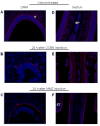Mechanisms of permanent loss of olfactory receptor neurons induced by the herbicide 2,6-dichlorobenzonitrile: effects on stem cells and noninvolvement of acute induction of the inflammatory cytokine IL-6
- PMID: 23921153
- PMCID: PMC3805741
- DOI: 10.1016/j.taap.2013.07.020
Mechanisms of permanent loss of olfactory receptor neurons induced by the herbicide 2,6-dichlorobenzonitrile: effects on stem cells and noninvolvement of acute induction of the inflammatory cytokine IL-6
Abstract
We explored the mechanisms underlying the differential effects of two olfactory toxicants, the herbicide 2,6-dichlorobenzonitrile (DCBN) and the anti-thyroid drug methimazole (MMZ), on olfactory receptor neuron (ORN) regeneration in mouse olfactory epithelium (OE). DCBN, but not MMZ, induced inflammation-like pathological changes in OE, and DCBN increased interleukin IL-6 levels in nasal-wash fluid to much greater magnitude and duration than did MMZ. At 24h after DCBN injection, the population of horizontal basal cells (HBCs; reserve, normally quiescent OE stem cells) lining the DMM became severely depleted as some of them detached from the basal lamina, and sloughed into the nasal cavity along with the globose basal cells (GBCs; heterogeneous population of stem and progenitor cells), neurons, and sustentacular cells of the neuroepithelium. In contrast, the layer of HBCs remained intact in MMZ-treated mice, as only the mature elements of the neuroepithelium were shed. Despite the respiratory metaplasia accompanying the greater severity of the DCBN lesion, residual HBCs that survived intoxication were activated by the injury and contributed to the metaplastic respiratory epithelium, as shown by tracing their descendants in a K5CreEr(T2)::fl(stop)TdTomato strain of mice in which recombination causes HBCs to express TdTomato in advance of the lesion. But, contrary to published observations with MMZ, the HBCs failed to form ORNs. A role for IL-6 in suppressing ORN regeneration in DCBN-treated mice was rejected by the failure of the anti-inflammatory drug dexamethasone to prevent the subsequent respiratory metaplasia in the DMM, suggesting that other factors lead to HBC neuro-incompetence.
Keywords: 2,6-dichlorobenzonitrile (or dichlobenil); DCBN; DEX; DMM; Dichlobenil; HBCs; IFN; IL; Inflammatory cytokines; K5; MMZ; Methimazole; Neurodegeneration; OE; OMP; ORNs; Olfactory stem cells; PBS; Regeneration; TNF; dexamethasone; dorsal medial meatus; horizontal basal cells; interferon; interleukin; keratin 5; methimazole; olfactory epithelium; olfactory marker protein; olfactory receptor neurons; phosphate-buffered saline; tumor necrosis factor.
© 2013.
Figures








Similar articles
-
Stem and progenitor cells of the mammalian olfactory epithelium: Taking poietic license.J Comp Neurol. 2017 Mar 1;525(4):1034-1054. doi: 10.1002/cne.24105. Epub 2016 Sep 27. J Comp Neurol. 2017. PMID: 27560601 Free PMC article. Review.
-
Differential effects of olfactory toxicants on olfactory regeneration.Arch Toxicol. 2002 Mar;76(2):104-12. doi: 10.1007/s00204-002-0321-2. Epub 2002 Feb 6. Arch Toxicol. 2002. PMID: 11914780
-
Stem cell CNTF promotes olfactory epithelial neuroregeneration and functional recovery following injury.Stem Cells. 2025 Jul 21;43(8):sxaf033. doi: 10.1093/stmcls/sxaf033. Stem Cells. 2025. PMID: 40401926 Free PMC article.
-
Increased Retinoic Acid Catabolism in Olfactory Sensory Neurons Activates Dormant Tissue-Specific Stem Cells and Accelerates Age-Related Metaplasia.J Neurosci. 2020 May 20;40(21):4116-4129. doi: 10.1523/JNEUROSCI.2468-19.2020. Epub 2020 May 8. J Neurosci. 2020. PMID: 32385093 Free PMC article.
-
Identification and molecular regulation of neural stem cells in the olfactory epithelium.Exp Cell Res. 2005 Jun 10;306(2):309-16. doi: 10.1016/j.yexcr.2005.03.027. Epub 2005 Apr 21. Exp Cell Res. 2005. PMID: 15925585 Review.
Cited by
-
Transcription factor p63 controls the reserve status but not the stemness of horizontal basal cells in the olfactory epithelium.Proc Natl Acad Sci U S A. 2015 Sep 8;112(36):E5068-77. doi: 10.1073/pnas.1512272112. Epub 2015 Aug 25. Proc Natl Acad Sci U S A. 2015. PMID: 26305958 Free PMC article.
-
Cigarette Smoke-Induced Cell Death Causes Persistent Olfactory Dysfunction in Aged Mice.Front Aging Neurosci. 2018 Jun 13;10:183. doi: 10.3389/fnagi.2018.00183. eCollection 2018. Front Aging Neurosci. 2018. PMID: 29950987 Free PMC article.
-
Aging and chronic inflammation: impacts on olfactory dysfunction-a comprehensive review.Cell Mol Life Sci. 2025 May 13;82(1):199. doi: 10.1007/s00018-025-05637-5. Cell Mol Life Sci. 2025. PMID: 40355677 Free PMC article. Review.
-
Stem and progenitor cells of the mammalian olfactory epithelium: Taking poietic license.J Comp Neurol. 2017 Mar 1;525(4):1034-1054. doi: 10.1002/cne.24105. Epub 2016 Sep 27. J Comp Neurol. 2017. PMID: 27560601 Free PMC article. Review.
-
COVID-19 and olfactory dysfunction: a looming wave of dementia?J Neurophysiol. 2022 Aug 1;128(2):436-444. doi: 10.1152/jn.00255.2022. Epub 2022 Jul 27. J Neurophysiol. 2022. PMID: 35894511 Free PMC article. Review.
References
-
- Beites CL, Kawauchi S, Crocker CE, Calof AL. Identification and molecular regulation of neural stem cells in the olfactory epithelium. Exp Cell Res. 2005;306:309–316. - PubMed
-
- Bergman U, Brittebo EB. Methimazole toxicity in rodents: covalent binding in the olfactory mucosa and detection of glial fibrillary acidic protein in the olfactory bulb. Toxicol Appl Pharmacol. 1999;155:190–120. - PubMed
-
- Bergman U, Ostergren A, Gustafson AL, Brittebo EB. Differential effects of olfactory toxicants on olfactory regeneration. Arch Toxicol. 2002;76:104–112. - PubMed
-
- Bergstrom U, Giovanetti A, Piras E, Brittebo EB. Methimazole-induced damage in the olfactory mucosa: effects on ultrastructure and glutathione levels. Toxicol Pathol. 2003;31:379–387. - PubMed
-
- Brandt I, Brittebo EB, Feil VJ, Bakke JE. Irreversible binding and toxicity of the herbicide dichlobenil (2,6-dichlorobenzonitrile) in the olfactory mucosa of mice. Toxicol Appl Pharmacol. 1990;103:491–501. - PubMed
Publication types
MeSH terms
Substances
Grants and funding
LinkOut - more resources
Full Text Sources
Other Literature Sources
Medical
Molecular Biology Databases
Research Materials

